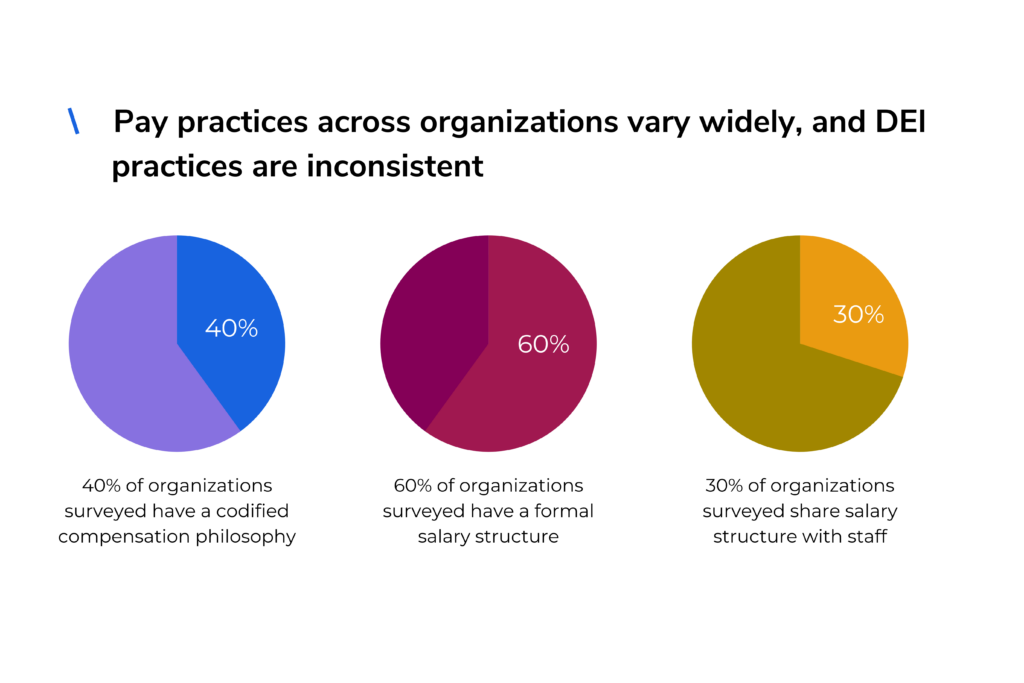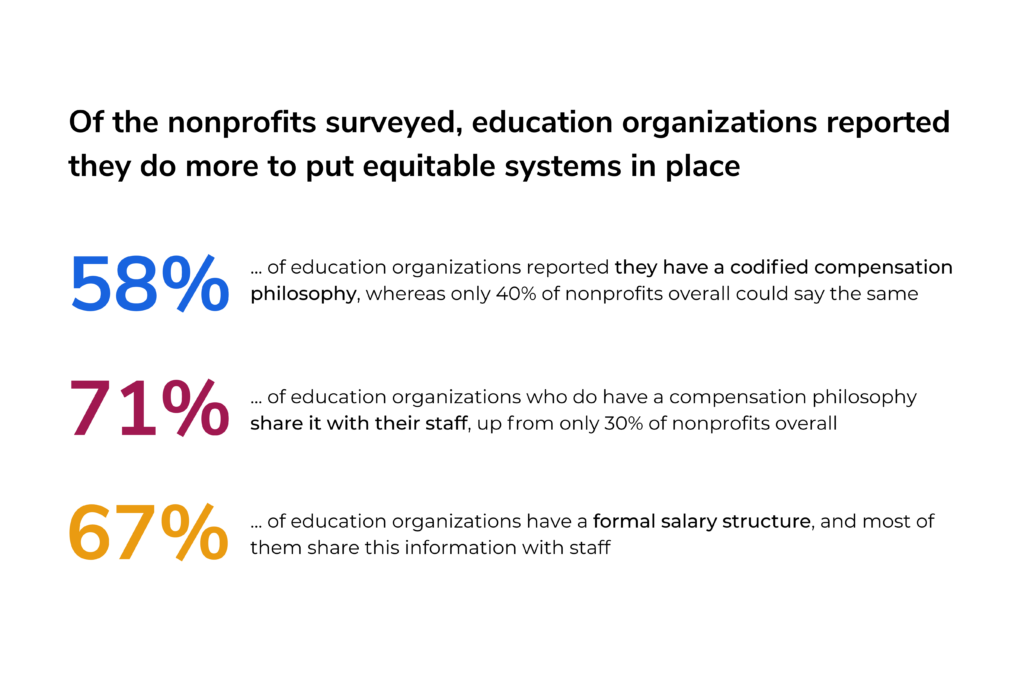
Inequity at Work: Making Your Talent Practices Match Your Values
A Study of Bay Area Organizations Reveals Income and Opportunity Gaps
OVERVIEW
Many nonprofits have missions to build a more equitable world, where race, gender, and other demographics don’t define people’s chances in life. But data from our recent study of Bay Area nonprofits shows that some of these organizations may not be living up to their values when it comes to hiring, pay, promotion, and support.
Over the past year, we studied compensation practices at dozens of Bay Area nonprofits, examining validated staff salary and demographic data for thousands of employees. We found that even in the Bay Area, a place globally known for its attention to social justice, every other demographic group ranks behind white men in pay — a gap that would take $30 million to close. Latina women are the most likely affected, forgoing thousands of dollars each year.
In some ways, these inequities are unsurprising, as so many organizations might not have access to the tools that could potentially head off these problems. Almost half of these organizations have a formal salary structure, but only 3 in 10 have shared such a structure with staff. Many don’t utilize a codified approach to compensation, a measure which could help ensure equity. Additionally, white men report being given more opportunities in the workplace allowing them to grow into more senior positions.
A few specific changes can speed progress toward greater equity in pay and career opportunities, and there’s no better place to start than in organizations with missions committed to equity. One crucial step to increase equity is to put compensation protocols in place to close the typical wage gap between white men and people of color.
Following these research findings, we have included a list of recommendations and changes every organization — nonprofit or otherwise — could, and should, make tomorrow. This report outlines numerous actions, both big and small, that organizational leaders can take to help close the wage and opportunity gaps that exist.
KEY FINDINGS
Wage Gaps
Our research of Bay Area organizations finds that every other demographic group is underpaid compared to white men. Statistically significant, large wage gaps by race and gender-identity exist even when controlling for other factors related to compensation (such as employee role, time in job, etc.).
Edgility research reveals the immensity of the gap, which occurs most dramatically between Latina women and white men but affects every demographic group. Controlling for other factors, being a Latinx female-identified employee can be indicative of earning more than $6,000 less in base salary than being a white male-identified employee. These wage gaps are consistent across organization size, issue area and scope.
Even when we do not control for similarly situated staff members, we observe differences in how different racial groups access the highest-paid roles in their organizations. White staff are about 1.5x more likely to earn a top quartile salary than non-white employees.

Part of the problem is that organizations might not have pay structures in place to help ensure equitable practices, so they are forced to rely on market benchmarks that may be inequitable in the first place. When setting salaries, 9 in 10 organizations said they consider market benchmarks. Using benchmarks to set salaries can hurt women and people of color because it reinforces existing structures and pay rates.
Education Nonprofits
Compared to other nonprofits, education organizations are more likely to have formal compensation philosophies and compensation structures and to have senior staff members tasked with leading diversity, equity, and inclusion (DEI) initiatives.

However, despite these efforts, they may still struggle with significant income gaps. Compared to white employees, Latino employees experience an annual wage gap of more than $11,000. Black employees make an average of $5,000 less and women make $7,637 less than their male counterparts.
Opportunity Gaps
The opportunity gap seen between white men and everyone else is concerning.
Our recent Talent Equity Assessment research of nonprofit organizations finds that white men are given more opportunities than women or people of color in the workplace. Senior staff spend more time coaching and mentoring white men, who in turn tend to receive higher performance ratings – 90% of white men report receiving a high rating or performance review in the year, compared to only 75% of black men.
White men are 11% more likely to report they have been given stretch opportunities, allowing them to advance faster than others. Ultimately, these opportunities lead to professional growth and success for white men, helping them move up in seniority and further widening income gaps. This opportunity gap likely reinforces the wage gap, and the cycle continues.
THE PROBLEM PERSISTS
Well-intentioned organizations may struggle with equity because essential tools are missing. Organizations tend to lack protocols to support compensation equity. Although 90% of nonprofits reported having at least one staff member formally tasked with supporting DEI as part of their job responsibilities, organizations still struggle to handle this well.
A minority of organizations offer additional compensation for staff leading DEI initiatives that fall outside their established job function, which further highlights the need for more consistent policies that prioritize and honor DEI work.
Slow progress is being made. 21% of organizations reported convening a DEI Task Force or Working Group, an important first step in moving equity forward. 45% reported conducting an annual protocol to monitor compensation inequities.
The wage gap is clear and the opportunity gap is clear, but not all organizations are properly equipped to disrupt the pattern. We recognize that compensation equity is not a small or easy task to achieve, but we believe there are key steps organizations can take now to create radical, systemic change.
EDGILITY’S CALL TO ACTION
Compensation equity is possible.
Compensation transparency and clarity is a key driver of retention and engagement. Edgility recommends that organizations serious about DEI do more to demonstrate their commitment. Below are four key steps organizations can take to close wage and opportunity gaps that may exist at their organizations.
First, organization leaders and executives must take the lead and put policies and practices in place to ensure equity is resolved. For career pathways, performance management, and compensation, organizations need:
- Clarity and transparency: If your policies are clear and transparent, staff know what to expect from your organization. This helps prevent assumptions about decision-making criteria and makes your total value proposition less fuzzy.
- Fairness and consistency: Once expectations are normalized, it’s crucial that policies are implemented fairly and consistently. Implementing regular audits, leadership training and clear decision-making autonomy prevent exceptions from undermining the system.
- Inclusion and belonging: Clear and consistently implemented policies only work if they impact all staff similarly, regardless of their identity, role or background. It’s important to prioritize inclusion and belonging to ensure well intended policies don’t leave segments of staff feeling undervalued, isolated or disadvantaged.
Second, organizations should conduct annual self assessments to evaluate talent practices for equity.
Third, organizations should look for wage gaps as part of annual salary planning, then remedy them. This includes evaluating salary, bonuses and performance ratings by demographic group.
Fourth, leaders must conduct annual self-assessments to evaluate talent practices and isolate opportunity gaps. Look at your net promoter score, total value proposition and our Edgility Equity Index by demographic group.
ABOUT EDGILITY
Edgility exists to empower organizations to recognize and overcome unconscious bias, racism, and sexism to build workforces that reflect and strengthen the communities they serve. We help clients put their values to work to ensure more equitable hiring, retention and employment practices. We know that people are what matters most in almost every field — especially in social impact organizations. Yet default practices reinforce existing, oftentimes flawed structures, costing organizations the genius and diversity they need. We work with organizations to run executive searches to place transformational leaders, then we help those and other social impact organizations bring practice and structure into alignment with their values.
Equity can’t just be a belief, it has to be a set of actions.
We hope our learnings from this report serve as strong evidence for the need to invest significant time and resources towards auditing current compensation practices and building out the policies, tools, and practices needed to advance workplace equity.
Download this report here. View this report in presentation form here.





